Stories from Indonesia
The emergency phase may be over, but the rebuilding and recovery will take years
Slowly returning to normal…
It’s two o’clock in the morning at Jakarta airport, yet the Garuda plane for Palu is full. There are no humanitarian workers or tourists. The plane is full of locals carrying huge plastic bags full of all sorts of products they cannot find in Palu anymore. The flight takes off from Java – one of Indonesia’s 17,504 islands.
Two and a half hours later, the plane begins its descent towards Palu, a coastal city on Sulawesi Island. I expect a difficult landing, like the one the last time I was here. But this time, the pilot brakes much more slowly and the plane does not hop on the tarmac. I look at both sides of the tarmac: the military helicopters and those of the BNBP (the government agency that coordinates the emergency response following the earthquake of September 28) have disappeared. There is no military presence, no improvised immigration office at the entrance. Outside, dozens of cars are waiting in double file. The last time I landed here a month ago, the airport was almost deserted and the atmosphere so heavy.
Here at least, Palu seems to have returned to normal. On the road, Brian, our driver who has a big smile and dark black hair, confirms my impressions: “Yes, Palu is slowly returning to normal. But outside the city, in the affected areas, people’s living conditions remain… terrifying. Look, just by saying it, I get goose bumps.”
So much has certainly changed in just one month. Officially, the emergency phase decreed by the government came to an end on October 26, leaving room for a transitions phase that should go until December 25. Life begins again, little by little. But, according to the authorities, it will take at least two years to rebuild the city of Palu, and probably even more for the more remote areas.
Not one disaster, but three
The region of Central Sulawesi was hit not only by a one natural disaster, but by three simultaneous disasters: a violent earthquake of magnitude 7.5; a terrible tsunami that hit its coastal area for miles a few minutes later, with waves reaching 6 metres in height; and the destruction of entire villages, engulfed by land that had become marshy and shifting as a result of a geological phenomenon called liquefaction. “The earth trembles regularly here,” said Frilly, a 21 years-old girl from Palu who currently works as translator for Medair. “We are used to it. This time it was with incredible force. But we immediately understood what it was. The tsunami too, we have always known that coastal areas are at risk, so some of the inhabitants had moved inland in recent years. But nobody, nobody here had ever heard of liquefaction.”
Of seismic origin, this phenomenon can occur when soil saturated with water loses its lift, thus allowing the depression and the collapse of things built on top it. Several villages were literally engulfed and buried in the ground. “The earth had gone crazy, it looked like a blender,” said Frilly. “The earth was spinning, breaking, the houses were falling apart. It was so chaotic; it looked like the end of the world. ”
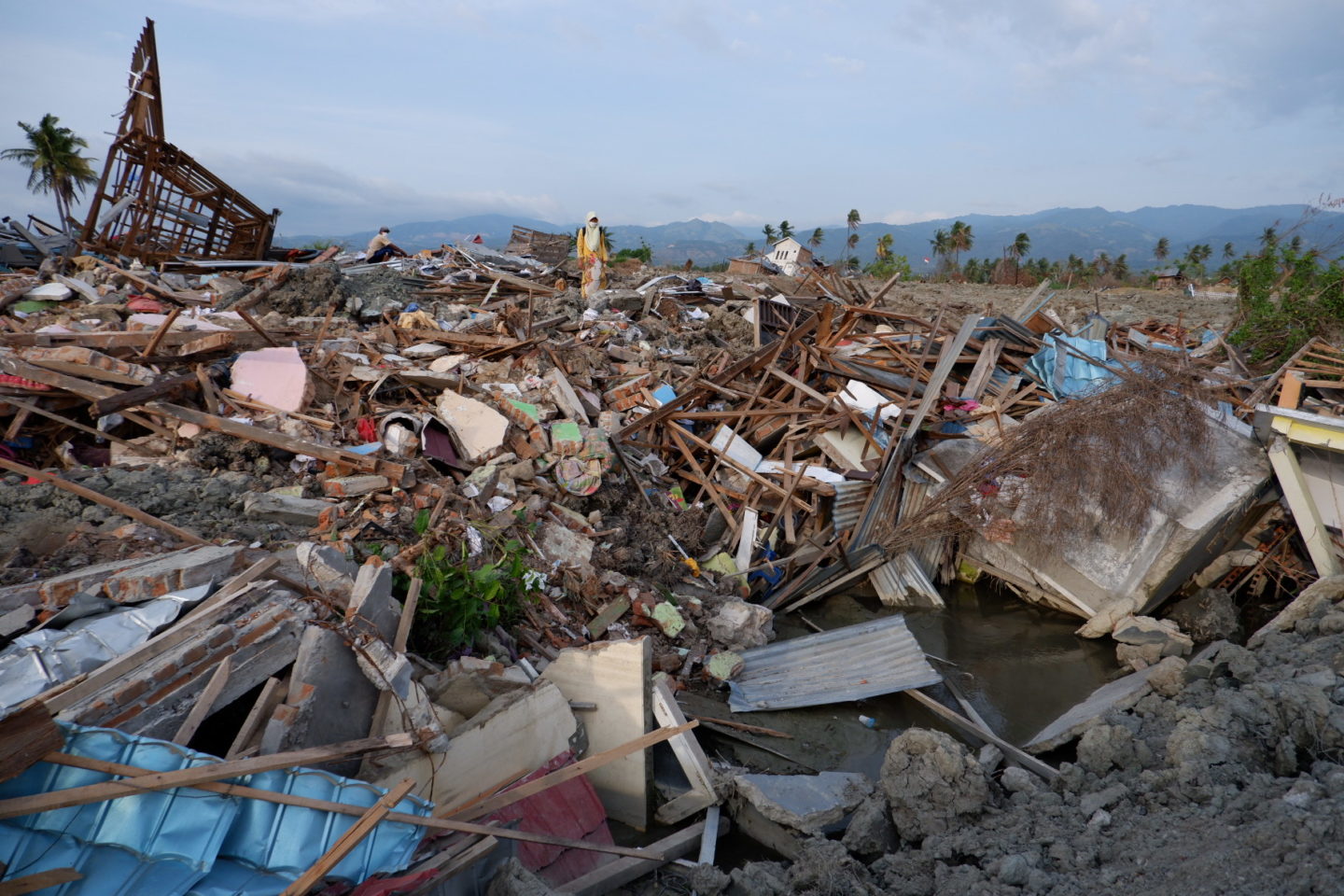
A picture showing devastation in Jono Oge, one of the areas that have been affected by liquefaction following the 28 September earthquake. @Medair / Andrea Cecchi
“Almost everyone here in Palu, Sigi, and Donggala was affected, directly or indirectly by the disaster,” said Frilly. “We all know someone who was injured or died. We are all trying to mourn. Everyone does it in their own way: some seek an explanation, someone or something to blame. Others are in complete denial, as if nothing had ever happened. Is there a good or bad way to react to that? Honestly, I am not able to say. For me and for my parents, what makes us go is to get back to work, to restart our activities. This makes us feel like active players and not passive victims of something that fell on us.”
This strength, this willingness to go forward despite all the difficulties, is what has struck me most in my meetings with communities that were affected by the disaster. Here are some things I heard from people during my my conversations in Sulawesi:
“I get up every morning to work at my new house, because Christmas is coming, and I want my family to have a new home or celebrate it.”
“My children tell me, ‘Daddy you must be strong, we need you:’ these are the words that make me go forward”.
While many remain deeply affected psychologically, their daily actions show remarkable resilience and strength. “I lost my courage, my hope,” said Kiki, a 20 years-old girl, staring out at the sea. She sat on a pile of debris, the remains of her shop in the coastal area of Taman Ria, Palu. And yet she was there, helping her brother wash the floor of a shop that no longer exists, one with no walls or ceiling, while secretly cultivating the hope of one day being able to resume her activity.
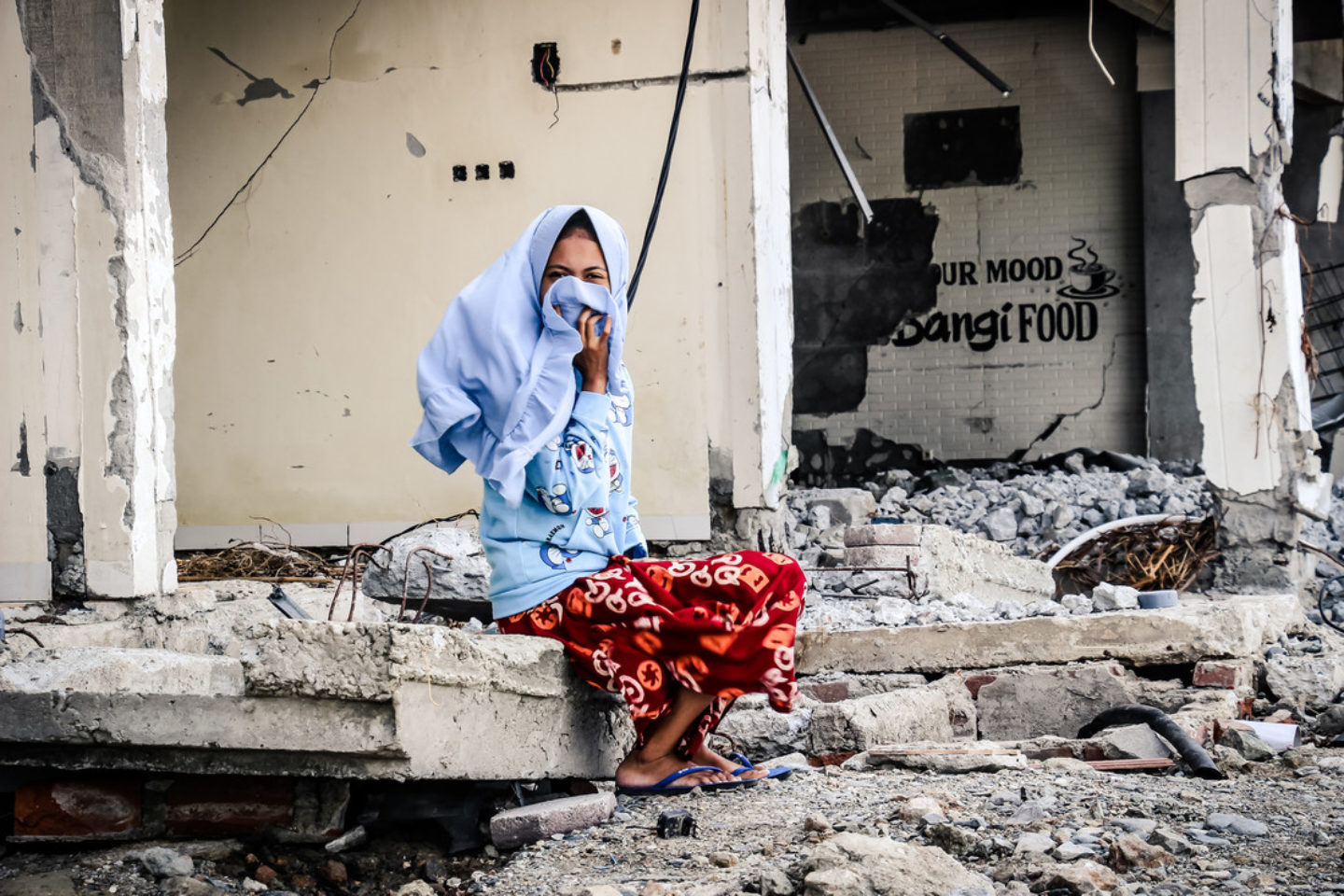 On September 28, local Palu resident Kiki was travelling from her home to her shop in Tamanria area, Palu, Indonesia’s Central Sulawesi. She witnessed first- hand the destruction of the tsunami waves, washing away buildings and sweeping people under the mud. “I don’t know how I can recover from this. Everything is gone, just gone”. @Medair / Paola Barioli
On September 28, local Palu resident Kiki was travelling from her home to her shop in Tamanria area, Palu, Indonesia’s Central Sulawesi. She witnessed first- hand the destruction of the tsunami waves, washing away buildings and sweeping people under the mud. “I don’t know how I can recover from this. Everything is gone, just gone”. @Medair / Paola Barioli
Invisible wounds
“People are scared now,” said Frilly. “Even my family who has been living here in Palu for years is now thinking about going away. We do not feel safe here anymore. My mother refers to it as a ‘state of terror.’ We are terrified at every new aftershock. According to official government figures, there have been more than 508 since September 28th. “People are emotionally very stressed. And every new aftershock just adds to it. ”
I remember the first time I came here in Palu, at the beginning of October. A strong aftershock of magnitude 5.4 had struck during the first hours of the morning. I watched as colleagues from the local NGO with whom Medair works jumped the two-metre high gate to escape, panicked. The following nights, the girl with whom I shared a room woke up several times in the night, at every noise of a door or car, shouting ‘Earthquake, earthquake!’, her eyes wide with fear.
When I speak to people here, I realize the trauma is still present in their heads. Septy is 26 years old. Her house in the coastal area east of Palu was completely washed away by waves. Now, she lives with her family and relatives in a makeshift camp built a few kilometres higher, towards the hills. She agrees to accompany us to the site of her former home. I want to take a picture of her, but she smiles nervously and stops, as if paralysed. And all of a sudden, I understand. I try to reassure her: “Do not worry, we can take the picture here,” I say. She looks at me, relieved: “I am still afraid of approaching the water.” She, like the hundreds of people who lived here, saw the black waves approaching, taking everything away. “The waves were as high as coconut trees and so black that we thought of smoke coming from the nearby power plant.”
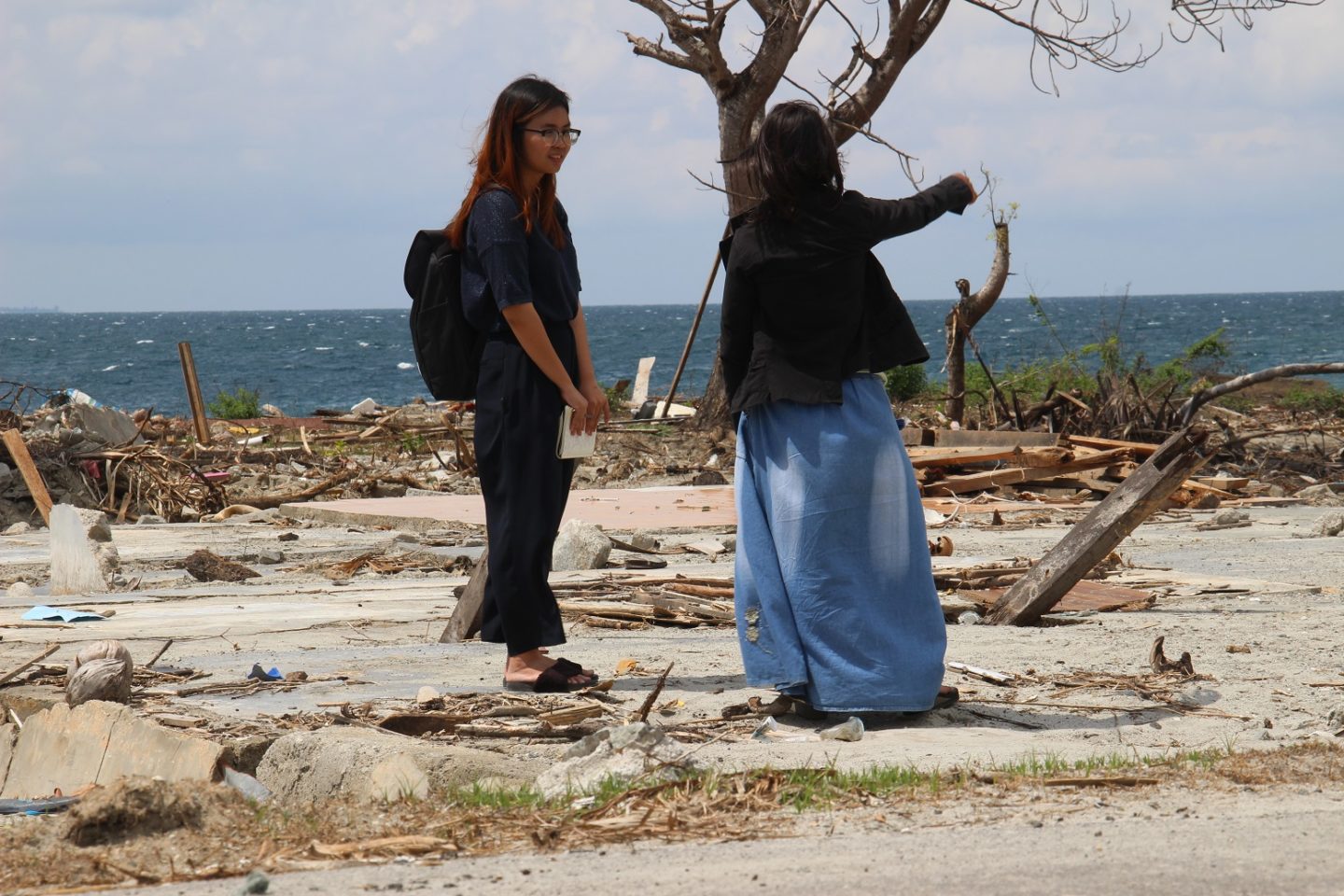 Septy, 26 years-old explains how the tsunami waves washed away her house in the coastal village of Kadongo, east of Palu. “The waves were tall like coconut trees and so dark that we initially thought it was smoke coming from the nearby electricity plant”. “I had never experienced something so close to death. It was the end of the world. I am still scared of approaching the water”. @ Medair/ Paola Barioli
Septy, 26 years-old explains how the tsunami waves washed away her house in the coastal village of Kadongo, east of Palu. “The waves were tall like coconut trees and so dark that we initially thought it was smoke coming from the nearby electricity plant”. “I had never experienced something so close to death. It was the end of the world. I am still scared of approaching the water”. @ Medair/ Paola Barioli
Rebuild houses, restore basic income
Almost two months after the disaster, entire areas have still not been cleared from debris. I walk among the debris, scattered memories of what was once a normal life: a clock, a plate, an armchair, a shelf. The government has promised to help in the reconstruction. But for the moment, no concrete plan has been proposed. “We know it will take time, certainly years,” the people of Palu tell me. And in the meantime, hundreds of people like Septy live in makeshift camps, built with whatever materials they could find on the spot: pieces of wood, items salvaged from the waves, and for the lucky ones, kits distributed by NGOs.
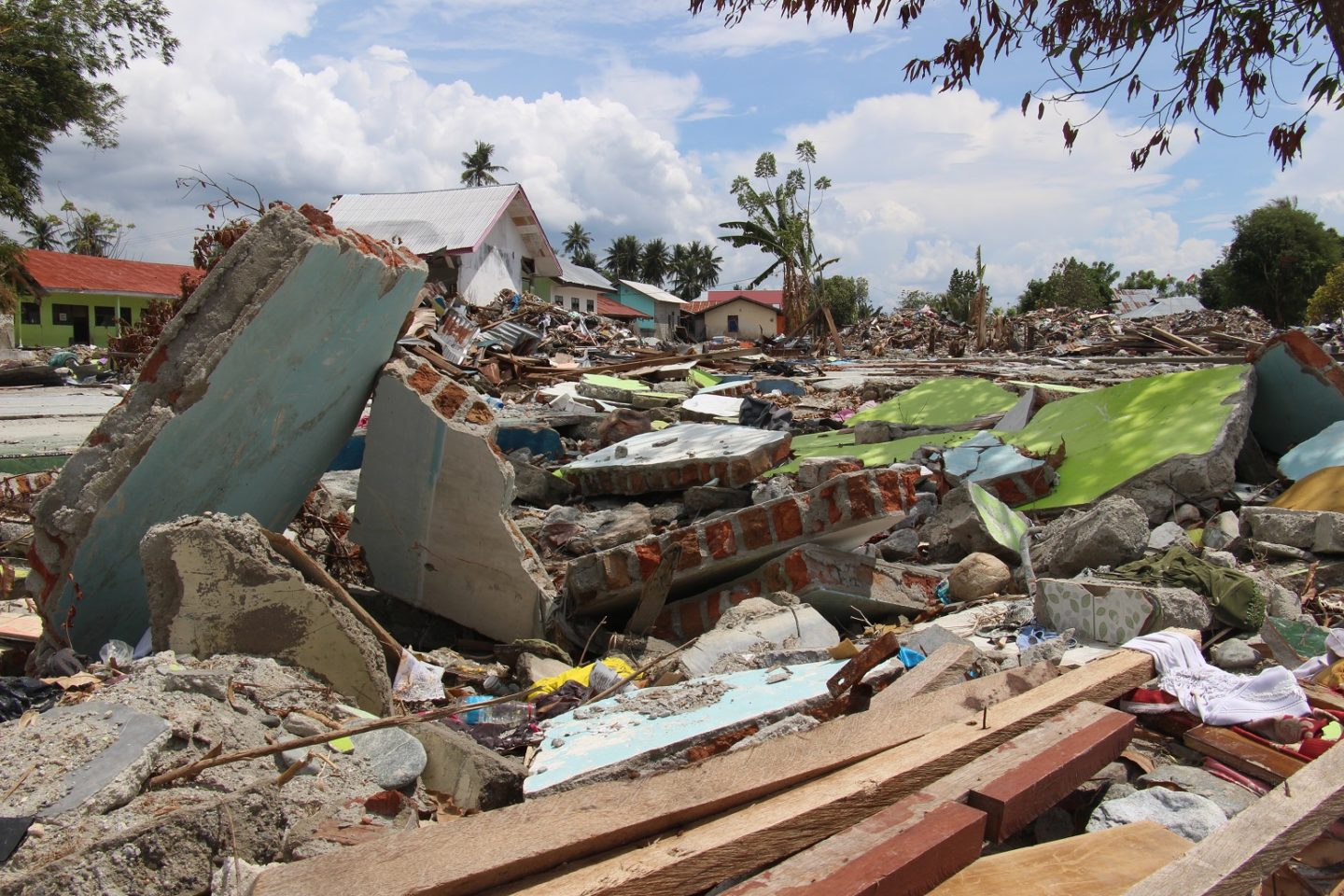
This picture shows the devastation along the coastal area of Panau, east of Palu, almost two months after the disaster. Authorities say it will take more than two year to rebuild the city of Palu. @ Medair / Paola Barioli
“We can at least rebuild a new house, a new home, even if it’s a temporary solution,” say Asriani and Suganda, a couple lining up to receive the emergency shelter kits distributed by Medair through its local partners on site. “I’m going to rebuild my house little by little. It will take time but I will rebuild it,” says another woman in broken English.
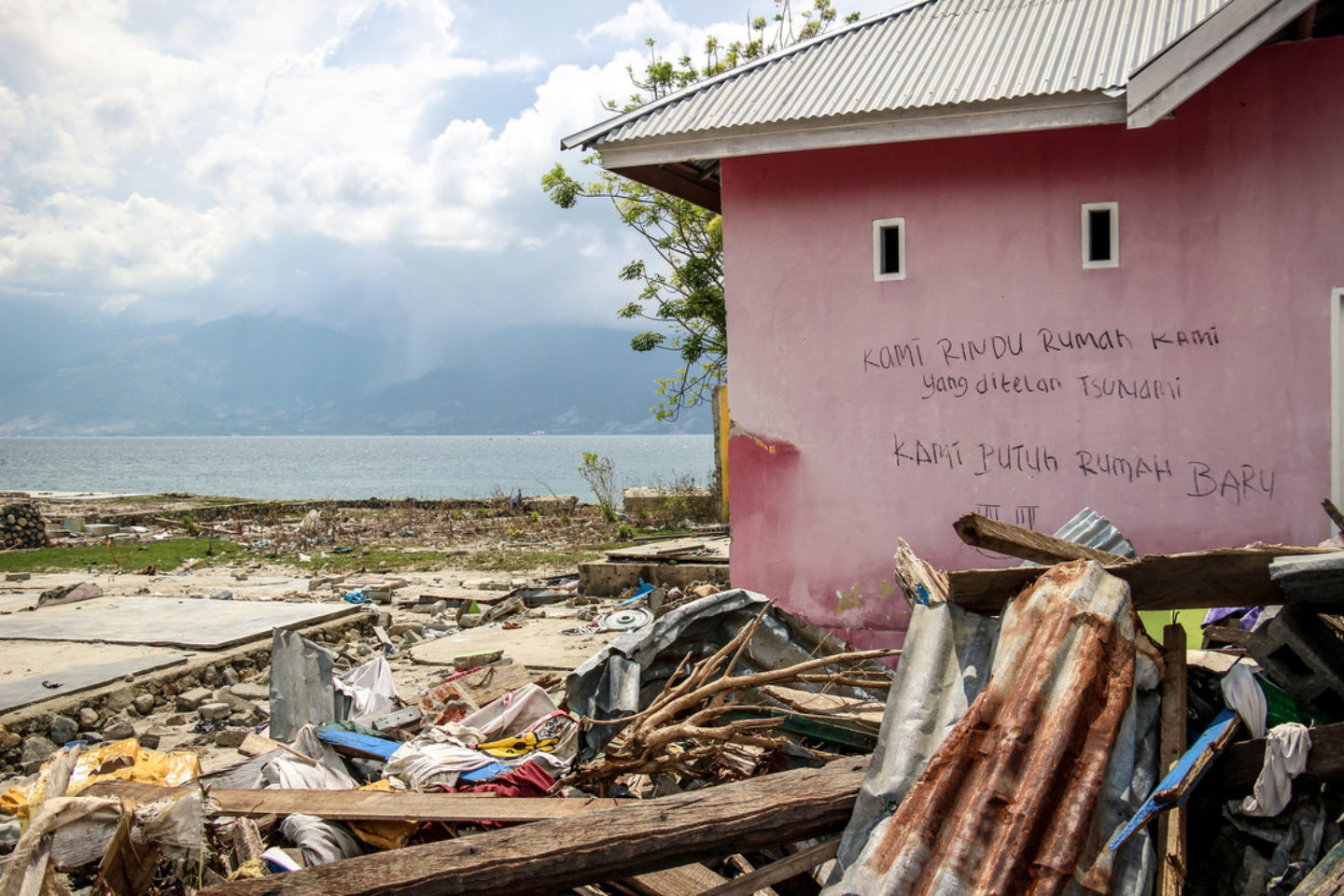
A house in the coastal village of Bamba,east of Palu. The tag on the wall says “We miss our homes taken by the tsunami. We need new homes”. People in the area have lost everything: their houses, their possessions and fishing tools, main source of income for their families. @ Medair/ Paola Barioli
But houses are not the only thing that the inhabitants of this area will have to rebuild in the months and years to come. Fishermen do not have boats anymore, farmers can no longer cultivate their fields, traders are lacking the funds needed to rebuild and restore their businesses. Even if the emergency phase is ver, the reconstruction phase is just beginning.
“At first I was scared of a new disaster,” said Taslim, a 52-year-old man. “I could not sleep at night. I cried all the time, I prayed to God to help me. Now I’m calmer, but it’s another fear that invades me, and this one is much deeper. I’m scared for the future; I’m scared because I do not know what’s waiting for me. I do not know if I will be able to support my family, if my son would be able to go to school.”
“Before, I grew my corn,” continued Taslim. “But now the soil has been affected, the plants are no longer growing. In addition, we lack seeds and tools. My only source of income no longer exists.
To move forward, to overcome this uncertainty and fear of the future, the people of Palu need to regain their autonomy to be able to meet the needs of their families.
Long-term consequences
Even if media attention about what happened in Palu has now sharply decreased, the consequences of the disasters that struck the heart of this Indonesian island are still very present for the local population.
“Palu is not Lombok,” said Frilly. “We are not a tourist destination. Our tragedy was quickly forgotten.” Yet the needs remain immense: the rainy season has begun and whole roads are blocked by floods. People live under makeshift shelters that fill with water and mud and are entirely dependent on external help. The emergency phase may be over, but rebuilding the homes and lives of affected communities will take years.
“Palu is still my home, even though my house is no longer there,” said Masdiana, 56. In a nearby tent, children sing a famous Indonesian song whose words were changed after the disaster: “Palu is strong, Palu is rebuilding, Palu will rise again.”
But for this to be possible, all of us—national and international actors directly or indirectly involved in the response—must continue to support reconstruction efforts in the coming months.
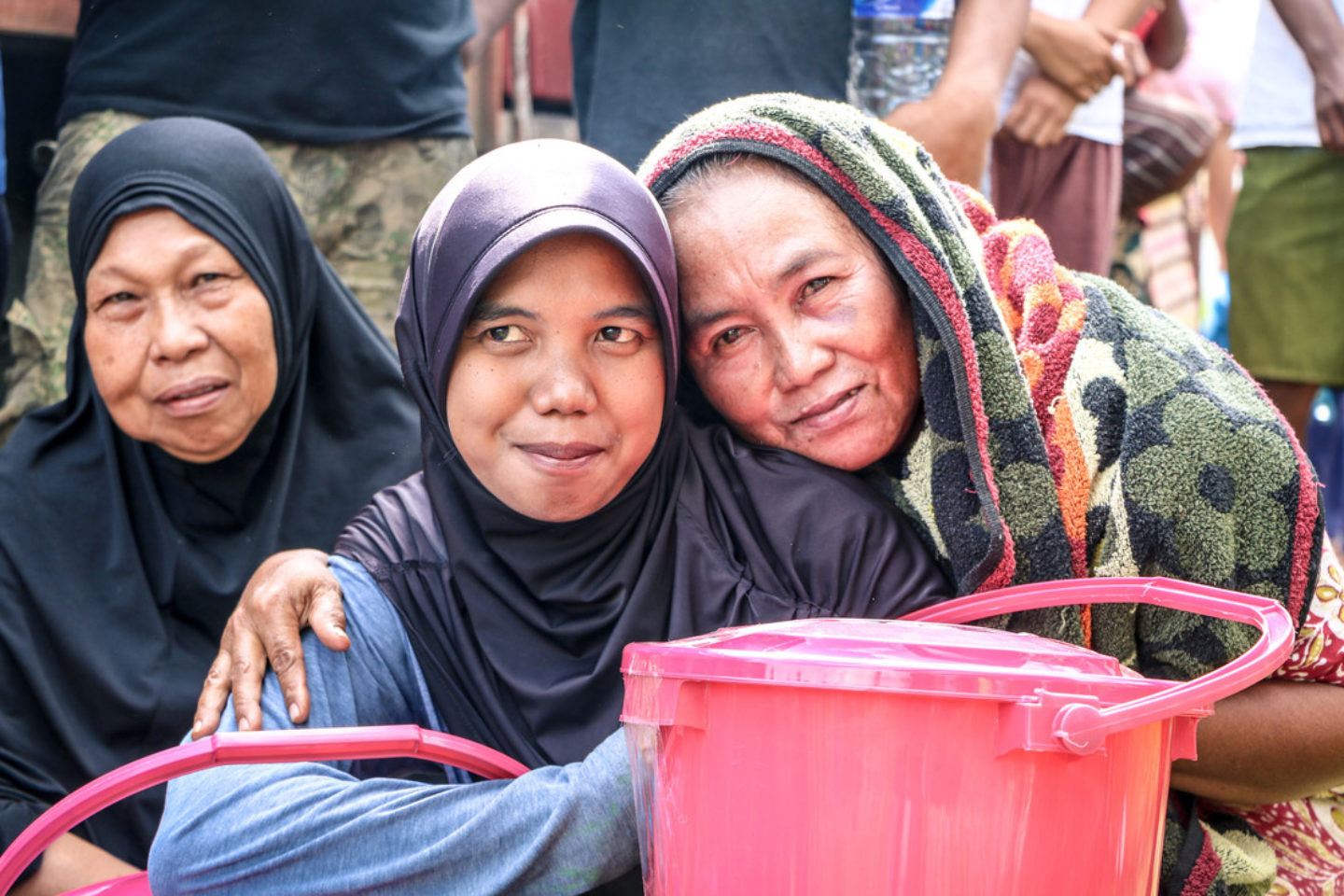
Fitriani and Fadli have just received the hygiene kits from Mediar’s partner MAP Indonesia in Simoro village, Sigi. The 28 September earthquake destroyed or damaged most of the houses in the village. @ Medair/ Paola Barioli
In accordance with the Government of Indonesia’s requirements, Medair in Indonesia is working through local partners. In Central Sulawesi, Medair has established relationships with three locally registered NGOs: Yayasan Menara Agung Pengharapan (MAP); Yayasan Bumi Tangguh (YBT); and Cipta Fondasi Komunitas (CFK).
As part of the initial emergency response phase, Medair – through its local partners MAP and YBT – is distributing emergency shelter, and basic household items and hygiene kits to the affected population. This initial response phase will serve 6,425 households (22,488 beneficiaries) in the affected areas of Palu, Sigi and Donggala. Medair serves as the lead in coordinating and managing the project, providing technical advice and on-the-job training to local partners, ensuring quality distributions, monitoring/evaluation, and programme support.
Medair is currently exploring the possibility of starting a cash-for-work programme in the months to come, in line with government guidelines and in partnership with a local organisation.
